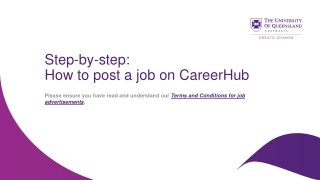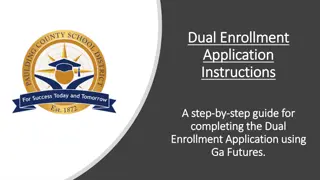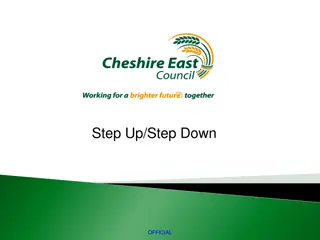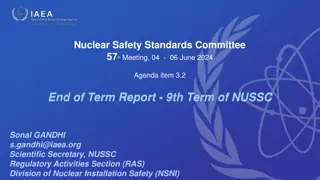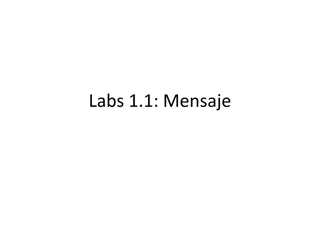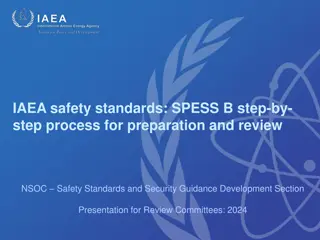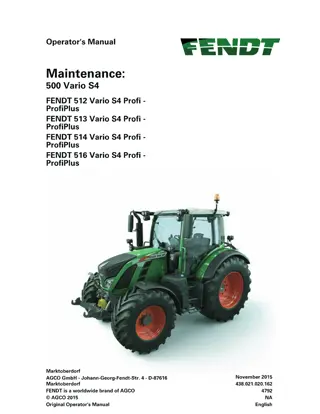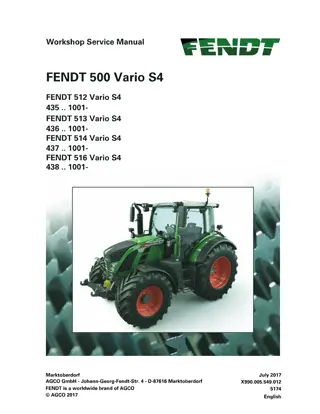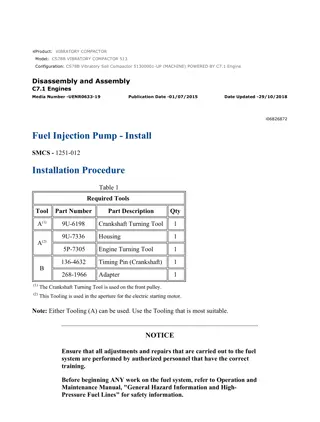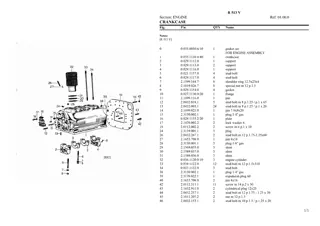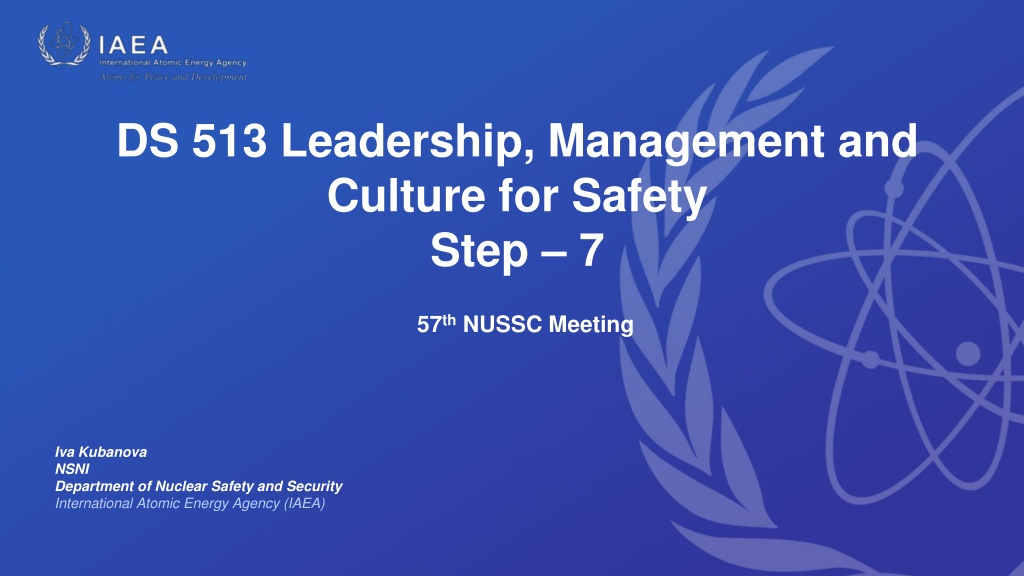
DS 513 Leadership Management and Culture for Safety Overview
Explore the overview and status of DS 513, a document by Iva Kubanova from the IAEA, focusing on leadership, management, and safety culture in nuclear facilities. Learn about the revisions, new recommendations, and the approval process leading up to the current stage of development.
Download Presentation

Please find below an Image/Link to download the presentation.
The content on the website is provided AS IS for your information and personal use only. It may not be sold, licensed, or shared on other websites without obtaining consent from the author. Download presentation by click this link. If you encounter any issues during the download, it is possible that the publisher has removed the file from their server.
E N D
Presentation Transcript
DS 513 Leadership, Management and Culture for Safety Step 7 57thNUSSC Meeting Iva Kubanova NSNI Department of Nuclear Safety and Security International Atomic Energy Agency (IAEA)
Background DS 513 is revision of GS-G-3.1 Application of the Management System for Facilities and Activities which was issued in 2006
DS 513 in IAEA Safety Standards Hierarchy GSR Part 2 Leadership and Management for Safety DS 513 Leadership, Management and Culture for Safety Revision of GS-G-3.1 (all facilities and activities) GS-G-3.5 (nuclear Installations)
Overview of the Document The scope of GS-G-3.1 extended(recommendations must cover also new requirements relevant to leadership and culture for safety in GSR Part 2 issued in 2016) The new information in DS513 includes Recommendations relevant to leadership and culture for safety New version of Safety Culture Model (based on Harmonized Safety Culture Model) Recommendations related to graded approach which are distributed in the whole text (not in an appendix as planned originally) Other Changes The document reflects recent development in the area of leadership, management and culture for safety Material more suitable to guidance removed
Status of the Document / 1 The DPP was approved by the Committees in December 2019 New Technical Officer was assigned in September 2020 Iva Kubanova The work started with 3 virtual Consultancy Meetings during 2020. Main purpose was to finalize gap analyses from previous period comparing GSR Part 2 requirements with the text of safety guide GS-G-3.1 and partially GS-G-3.5. The first draft of document was developed by group of consultants in November 2021. The Technical Meeting (in-person) was organized in April 2022 in Vienna (26 participants from 22 Member States from different organizations -nuclear and radiological regulatory bodies, NPPs operators, NEPIOs, Hospital) 2 other Consultancy Meetings organized in 2022 (modification of text after TM) and 2023 (graded approach appendix development) Internal IAEA review process started in August 2023 (NSNI division, Standards Specialists, MTCD mini-APA) Coordination Committee approved the draft text in November 2023
Status of the Document / 2 The draft text published for Committees comments on 7th March 2024 with deadline May 13th Table with resolution of comments posted on 24th May 2024 together with draft text in change mode and in clean version Submission for approval to the following committees: NUSSC RASSC WASSC TRANSCC EPReSC NSGCC
SSC Member Comments: Statistics of Comments Received until 15th May (incl.) NUSSC : 284 comments (in 16 files) RASSC : 113 comments (in 5 files) WASSC : 4 comments (in 3 files) TRANSCC : 21 comments (in 1 file) EPReSC : 17 comments (in 4 files) NSGCC : 71 comments (in 6 files) TOGETHER : 510 comments (about 55% accepted or modified, 45% rejected) Note: same comments from Finland and WNA were provided to several committees (numbers counted in each committee)
SSC Member Comments: High Interest Many comments provided to: leadership part quoting GSR part 2 (many corrections were done) linguistic aspects Challenges: to understand the status of Safety Guide within Safety Standards structure and keep the text accordingly to keep safety guide content applicable for all facilities and activities (different interests) to keep the text brief and sound
SSC Member Comments: Not Addressed / 1 Reference to ISO standards IAEA does not promote and reference single sources ISO standards do not undergo IAEA Member States consensus process IAEA does not have influence on how ISO standards will be developed in the future IAEA Safety Standards create a base for IAEA safety review missions and IAEA is not authorized to check compliance with ISO standards Reference to lower level of IAEA publications (like TECDOC) SPESS C : Safety Guides and Implementing Guides should not reference TECDOCs
SSC Member Comments: Not Addressed / 2 Request to add security everywhere that safety is used Discussed several times in NUSSC and NSGC and rejected; the main reason was that we cannot develop common document for safety and security without all relevant changes of security documents To decrease number of recommendations in leadership area versus to increase Balanced approach was applied; recommendations must be applicable for all types of facilities and activities like - NPPs - Fuel cycle facilities - Hospitals - Veterinary clinics - NDT companies - Oil industry - Research centres - Universities - Airports with security X-rays - A regulatory body
SSC Member Comments: Not Addressed / 3 To move appendix on Safety Culture Model to annex Safety culture model is a part of current GS-G-3.1, recommendation 2.36; if we move model to an annex then it is an information only, not recommendation Request to decrease graded approach oriented recommendations Originally special appendix was dedicated to graded approach but final decision was to dilute the appendix in the body text (after IAEA internal review) Request for more guidance on management system in small organizations The question is what can be designed for the whole spectrum of small organizations Request to move some recommendations between sections (or have some of them in parallel in more sections) Subjective opinions; moreover each recommendation must be unique text and number
SSC Member Comments: Summary Number of comments received : 510 Number of comments accepted or accepted with modification about 55% Number of rejected comments about 45% All comments are addressed in a resolution table
Action Requested Approval by NUSSC RASSC WASSC TRANSCC EPReSC NSGCC for submission to Member States
Thank you! i.kubanova@iaea.org



